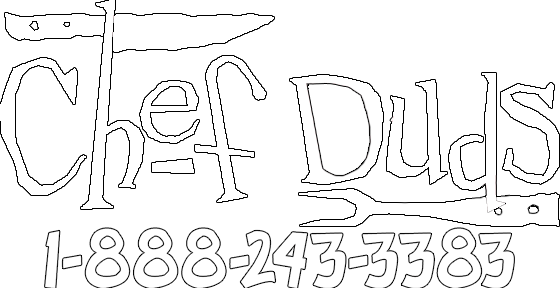please allow 3 business days for embroidered items to ship
- Products
- Your Store
- Farmers Restaurant Group
- California Dreaming
- Yardbird
- Ad Lib
- Cowfish
- Chica
- Spring Chicken
- Uno
- EEZ Fusion
- Huddle House
- Red Lobster
- Tin Drum
- Matchbox
- Pizzeria UNO
- Gulfstream Cafe
- Carolina Roadhouse
- New York Prime
- Chophouse 47
- Forrest Fire
- Fish HHI
- SC Yacht Club
- Local Pie
- Tennessean
- Two Cities
- Halls Chophouse
- Halls Catch
- High Cotton
- Punch Bowl Social
- Punch Bowl Corporate
- Other Products
- Sale!
- News
- About Us
- Contact Us
- My Account
please allow 3 business days for embroidered items to ship
Back to the Future
August 15, 2013
Summary : Today's fabrics make tomorrow's chef coats, and Chef Duds is leveraging the latest in technologically advanced materials to build better chef wear. Take a quick stroll down memory lane to see how the industry trends have grown over the years...
By Kim Bucher | Published : 1/16/2013
 If there is one constant when it comes to style, it’s change. This even holds true for chef coats. Just yesterday, I was looking at some pictures of restaurants and kitchens from the 1960s and 70s. To my surprise, the chef coats worn in these pictures were virtually the same as the Chef Duds basic chef coat #7000. These jackets featured the same pearl buttons and distinct collar styles that contemporary chefs choose today. In fact, at first glance, the coats look almost identical—except for the fashion scarves that were popular during that era.
If there is one constant when it comes to style, it’s change. This even holds true for chef coats. Just yesterday, I was looking at some pictures of restaurants and kitchens from the 1960s and 70s. To my surprise, the chef coats worn in these pictures were virtually the same as the Chef Duds basic chef coat #7000. These jackets featured the same pearl buttons and distinct collar styles that contemporary chefs choose today. In fact, at first glance, the coats look almost identical—except for the fashion scarves that were popular during that era.
Upon closer examination, though, I noticed that there were no arm pockets on the jackets. Over the past 15 years I have witnessed dramatic changes in chef uniform designs, including the classic coat design. One of the most dramatic changes has been in the fabric used to make chef coats. Where coats from the 1960s and 1970s were predominantly made of 100 percent cotton, today’s chef jackets are constructed of durable, unique wash-and-go fabrics. These modern fabrics come with a variety of added benefits, such as soil release, stain resistance, color enhancers, and stiffness additives.
These added features have not only made the coats today much easier to launder and keep clean but they have also added life to the garment. In years past bleach was the common product used to clean and rid the coat of stains. Unfortunately, extended use of bleach products also degrades and yellows the cotton in the coat. Today’s fabrics are built with soil resistant’s right on the coat which help in the laundering process. Less bleach is needed and this effectively adds life to the garment.
Given all of these options (and more!), the real trick is to determine the right mix of options to meet customers’ diverse needs and budget. One obstacle to note, these fabric options are not visible to the naked eye. In fact, their presence is only found with a quick glance at the label. That’s why Chef Duds uses an extensive evaluation process to find the items in our collection that fit the customer’s precise specifications. To supplement this evaluation process, our team members stay fresh on market trends and truly listen to what customers want.
For example, last year we had a customer who asked if we had a long sleeved cook shirt. I asked why he would want a long sleeve cook shirt when we had a plethora of long sleeve chef coat options. He said that his kitchen was extremely hot and the owner made them wear long sleeves for safety reasons. That was the conversation that started the birth of our light weight poplin chef coat line. From there the mesh back coat was added. The number one comment of our customers was that they wanted a stylish but very light weight coat. A simple 5 minute conversation created what we call our poplin performance line.
Fabric is just one of many features that come together to make an outstanding chef coat. Upcoming articles will focus on the other elements that make a chef coat stand out, including button style, sleeve length, collar type, color, and piping. So, until next time stay safe in the kitchen.
Share:
Also in News
News & Updates
Sign up to get the latest on sales, new releases and more …
Chef Duds
Our mission is to create practical, comfortable, stylish uniforms for a fair price. We accomplish this with a knowledgeable and friendly staff to help you or your business find the ideal uniforms to represent your company. Whether you are looking for formal or casual wear, Chef Duds Inc. is committed to providing top-notch service and high-quality, detailed apparel at prices made for the industry.
FOR QUOTES AND EMBROIDERY DETAILS PLEASE EMAIL CHEFDUDS@GMAIL.COM
Main Menu
© 2024 Chef Duds. Designed by Out of the Sandbox. Ecommerce Software by Shopify
Size Chart

*All sizes indicated are pre-wash.

